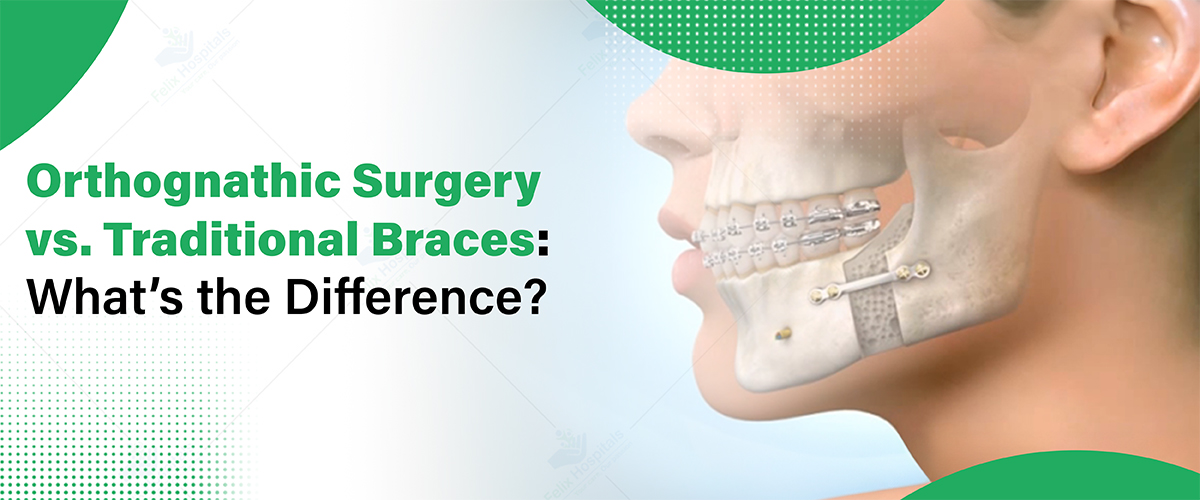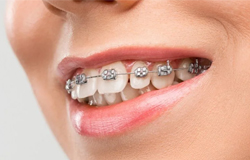
Subscribe to our

When it comes to correcting dental and facial irregularities, two common options often discussed are orthognathic surgery and traditional braces. Both methods aim to improve the alignment, function, and aesthetics of the teeth and jaws, but they serve different purposes and are suitable for different situations. In this blog, Let’s explore the key differences between orthognathic surgery and traditional braces, the conditions they address, the processes involved, and the factors to consider when making a decision.
For more information about the different orthodontic options available and to discuss your treatment possibilities, give us a call today at +91 9667064100!

Orthognathic surgery, also known as jaw surgery, is a surgical procedure that corrects irregularities in the jawbone and realigns the jaws and teeth to improve function and appearance. This type of surgery is typically recommended for individuals with significant jaw discrepancies that cannot be adequately treated with braces alone.
Orthognathic surgery can address several conditions, including:
Jaw Misalignment: Issues such as overbite, underbite, or crossbite that result from mismatched jaw sizes.
Facial Imbalance: Asymmetry in facial features caused by jaw irregularities.
Sleep Apnea: Obstructive sleep apnea related to jaw positioning can sometimes be treated through surgical intervention.
Difficulty Chewing or Speaking: Problems with jaw alignment may lead to functional issues.
The process typically involves several steps:
Initial Consultation: A thorough assessment by an oral and maxillofacial surgeon, often accompanied by dental specialists.
Diagnostic Imaging: X-rays, CT scans, and dental impressions to plan the surgical approach.
Surgical Procedure: Performed under general anesthesia, the surgeon repositions the jaw and secures it with plates and screws.
Post-Operative Recovery: A recovery period involving rest and limited jaw movement, followed by orthodontic adjustments if necessary.
Traditional braces are orthodontic devices made of metal brackets, wires, and bands used to straighten teeth and correct bite issues over time. They apply continuous pressure to the teeth, gradually moving them into their desired positions.

Traditional braces are effective for a variety of orthodontic issues, including:
Crowded Teeth: When teeth overlap or are too close together.
Gaps Between Teeth: Spaces that can affect both aesthetics and function.
Misaligned Teeth: Teeth that are crooked or not positioned properly.
Bite Issues: Conditions such as overbites, underbites, and crossbites can often be improved with braces.
The process of getting traditional braces typically includes:
Initial Consultation: Evaluation by an orthodontist to determine the best treatment plan.
Placement of Braces: Brackets are attached to the teeth, and wires are threaded through them.
Regular Adjustments: Patients return to the orthodontist every few weeks for adjustments to tighten the wires and monitor progress.
Removal of Braces: Once the teeth have shifted into the correct position, the braces are removed, followed by the use of retainers to maintain alignment.
| Criteria | Orthognathic Surgery | Traditional Braces |
|---|---|---|
| Purpose and Treatment Scope | Addresses skeletal issues and jaw alignment for severe cases; corrects underlying structural problems that braces cannot. | Focuses on dental alignment and minor bite adjustments for milder cases; does not involve surgery. |
| Duration of Treatment | Takes several months, including pre-surgical orthodontics, surgery, and post-op recovery; full healing can take up to a year or more. | Typically lasts 1-3 years, depending on case complexity; no surgery required. |
| Invasiveness | Involves surgery under anesthesia, with a significant recovery period; risks include infection and complications. | Non-invasive, no surgery; discomfort mainly from adjustments, minimal risks. |
| Cost Considerations | More expensive due to surgery; cost in India ranges from ₹15,00,000 to ₹30,00,000 or more. | More affordable; cost in India ranges from ₹2,50,000 to ₹5,00,000. Some insurance may cover parts of the treatment. |
| Post-Treatment Maintenance | May require follow-up orthodontics to fine-tune alignment and regular dental visits. | Retainers are prescribed after braces removal to maintain teeth position. |
Severity of the Condition: Consult with an orthodontist to assess whether your issues can be resolved with braces or if surgery is necessary.
Treatment Goals: Consider your aesthetic and functional goals. Orthognathic surgery may provide a more comprehensive solution for jaw-related issues.
Time Commitment: Evaluate how much time you are willing to invest in your treatment, considering the longer process for surgery.
Cost: Review your budget and insurance coverage to determine which option is financially viable for you.
Consultation with Specialists: Always seek advice from qualified dental professionals who can provide tailored recommendations based on your specific needs.
At Felix Hospitals, recognized as the best dental hospital in Noida, we take pride in offering exceptional dental care through our highly qualified specialists. Here are some of our top dentists:
With extensive experience in general dentistry, Dr. Aditi Narad focuses on providing personalized care to ensure optimal oral health for her patients. Her compassionate approach and dedication make her a trusted choice for dental treatments.
Specializing in cosmetic dentistry, Dr. Shinja Dixit is known for her meticulous attention to detail and innovative techniques. She is committed to enhancing her patients' smiles while prioritizing their comfort and satisfaction.
Dr. Aditi Sharma combines her expertise in restorative and preventive dentistry to deliver comprehensive dental solutions. Her patient-centered philosophy ensures that each individual receives tailored care for their unique dental needs.
If you are considering orthodontic treatment, contact us today to schedule a consultation with our expert orthodontists at +91 9667064100.
Both orthognathic surgery and traditional braces play crucial roles in orthodontics and dentistry, but they cater to different needs. Understanding the differences between these two treatment options is essential for making an informed decision regarding your dental health. If you have severe jaw misalignment or other complex issues, orthognathic surgery may be the right choice. However, for more straightforward dental alignment concerns, traditional braces can effectively meet your needs.
1. What is the main difference between orthognathic surgery and traditional braces?
- Orthognathic surgery corrects significant jaw and skeletal issues, while traditional braces focus on dental alignment and minor bite adjustments.
2. Who is a candidate for orthognathic surgery?
- Candidates typically include individuals with severe jaw misalignment, facial asymmetry, or functional issues like difficulty chewing or speaking that cannot be resolved with braces alone.
3. How long does each treatment option take?
- Traditional braces usually take 1 to 3 years, while orthognathic surgery involves several months for pre-surgical orthodontics, the surgery itself, and additional recovery time.
4. Is orthognathic surgery painful?
- While discomfort is expected post-surgery, pain management strategies are provided, and most patients find that the benefits outweigh the temporary discomfort.
5. Are there risks associated with orthognathic surgery?
- Yes, risks can include infection, complications from anesthesia, and issues related to healing. However, these risks are generally low with experienced surgeons.
6. What is the cost difference between the two treatments?
- Orthognathic surgery is generally more expensive, costing between ₹15,00,000 and ₹30,00,000, while traditional braces typically range from ₹2,25,000 to ₹5,25,000.
7. Will I need follow-up treatment after orthognathic surgery?
- Yes, many patients require additional orthodontic treatment after surgery to ensure teeth remain in the correct position.
8. Can insurance cover the costs of these treatments?
- Many insurance plans cover some costs for both braces and surgery, but coverage can vary significantly. It's best to check with your insurance provider.
9. How do I choose between these two options?
- Consult with dental professionals who can evaluate your specific needs, severity of your condition, treatment goals, and budget to determine the most suitable option.